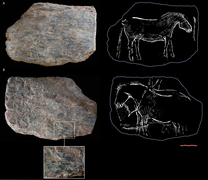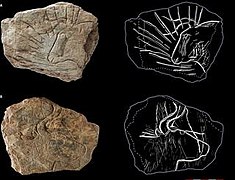Le rocher de l'Impératrice
Le rocher de l'Impératrice ( German rock of the empress ) is a rock about ten meters long and two to three meters wide at the foot of the Aremorican sandstone barrier . It is located north of the hamlet Toullar ar Rohou in Plougastel-Daoulas in the Finistère department in Brittany in France .
In 1987 Michel Le Goffic discovered 14,000 year old engravings, the oldest in Breton history, in the abbey beneath the Empress's rock. The rock has been excavated since 2013 and has proven to be a notable prehistoric site. The Abri was visited about 14,500 years ago, in the transition phase between the Magdalenian and the Azilia , according to radiocarbon data . The transition that takes place at Rocher de l'Impératrice is little documented in Europe. This site contributes to the understanding of this important phase of the Paleolithic by assessing the processes of change in a period characterized by the major environmental changes of the last glacial period . The studies and the archaeological material collected have shown that the hunters and gatherers used the area for a short period of time for hunting-related activities (making and using arrowheads and cutting soft animal materials).
- Finds at the Rocher de l'Impératrice
The location benefits from a remarkable view of the area of today's port of Brest , which was 14,500 years ago in a steppe that was drained by numerous rivers. With a sea level that was about 100 m lower, the coast was much further west at the level of the Île-Molène .
About 50 engraved slabs of slate were found on the site , which were probably brought with them by hunters and collectors because they do not occur locally. At the European level, the artistic evidence of the groups is particularly rare. The rock is a place where one can understand how the artistic culture of the Paleolithic societies changed during this time. While most of the elements are small fragments bearing geometric motifs (triangles and intersecting lines), some panels have drawings of horses or aurochs reminiscent of the drawings from the Magdalenian period ( Lascaux , Altamira , Niaux caves ). It seems that these groups, already changing their technical culture, initially retained their artistic tradition. It was also possible to determine dyes (based on charcoal) in the engravings.
literature
- Nicolas Naudinot et al .: Divergence in the evolution of Paleolithic symbolic and technological systems: The shining bull and engraved tablets of Rocher de l'Impératrice . PLoS ONE 12 (3), 2017. doi : 10.1371 / journal.pone.0173037
Remarks
- ↑ So named because of the visit of the Empress Eugénie de Montijo (1826–1920) to Plougastel.
Web links
- Le Rocher de l'Impératrice: un site exceptionnel on finistere.fr (French)
- Video of the excavation work (French)
Coordinates: 48 ° 23 '20.7 " N , 4 ° 22' 32.1" W.




